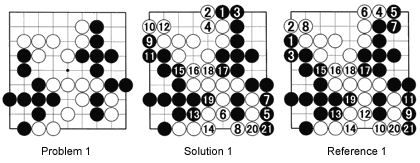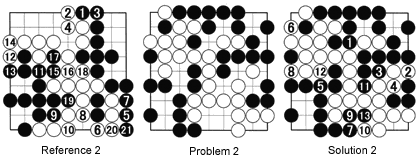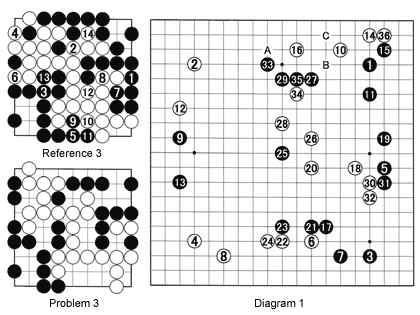Most players who become pro by the age of 14 win titles and the reverse is also true-most titleholders become pro before or by the age of 14.
The endgame
We started a discussion about the endgame a few weeks ago. We discovered that one of the most important principles is the difference between sente (a move that keeps the initiative by forcing a response) and gote (a move that loses the initiative). A difference even more compelling is that between double sente and double gote. Of course, counting is important, too.
Problem 1 :
Black plays first and wins the game (no komi). The important thing to remember is to keep sente.

Solution 1 :
Black should first play 1 to 3, because the hane-tsugi (a diagonal connecting stone and its connection) is double sente. Next, black 5 to 7 are sente, as are 9 to 11 and 13. This way Black keeps the initiative throughout the endgame to win the game by 2 points. Black 17 takes the last point (actually it forestalls a white point here). Moves 18 through 21 are worth zero points, but are played to fill in the dame points, meaning areas that have no value.
Reference 1 :
For comparison, if Black starts out with 1 and 3, which seem like sente, White will ignore him and play 4 to 6 first, which is double sente. If the game follows the same course, White wins by 2 points. As you can see, the difference in result is 4 points, exactly the value of the double sente moves.
Reference 2 :
So what happens when Black ignores the principle of first playing sente moves ? Up to 10, the game follows Solution 1, but then Black deviates by playing at 11, which is not sente at this stage. White takes the opportunity to counter with 12 to 14, to take away Black's sente combination here. White loses 1 point in the center, but he gains 3 points on the left side. The game therefore ends in a draw, or jigo.
Problem 2 :
Black plays first and wins the game (no komi). There are no sente moves here, and therefore counting is your first priority.

Solution 2 :
There are six main endgame situations still to be played, but all of them end in gote. In such cases, you must always play the biggest move. Black 1 is worth seven points. That is the biggest move, so Black plays here first. Each side then plays his remaining biggest move. White 2 is worth 6 points, black 5 is worth 5 points, white 6 has a value of 4 points, black 7 scores 3 points and white 8 is worth 2 points. Moves 9 through 13 are dame points.
Reference 3 :
So what happens when Black does not count properly? For example, if Black connects his three stones, figuring that saving three stones is better than saving one stone and capturing two stones, what will happen? If the game follows roughly the same course, it becomes a draw. As you can see, the difference in value between the two situations is accurately reflected in the game result.
Problem 3 :
Black to play first and win (no komi). This is an interesting problem as it demonstrates the importance of sente/gote. There are one sente situation and six gote situations. The answer to this problem will appear next week.

Iyama-Yamada game
Diagram 1 :This is the first game Yuta Iyama played as a pro. His opponent Kimio Yamada, 8-dan, played White. As compensation for the difference in strength, Black receives 5 points komi. This is the opposite of the usual 5-1/2(harf) points komi that Black has to give as compensation for playing the first move. In other words, Black may lose on the board by 4 points and still win the game.
Moves 1-5 form the low Chinese fuseki (opening maneuvers), a favorite among aggressive players. Black 17 threatens to set up a great moyo (framework) on the right side and White has to reduce with 18. Moves 21 and 23, and again 27, are excellent moves to attack the White invasion from a distance-this is a typical professional approach to an invasion. Black 29 is a little slow (see Reference 4).
After white 30 and 32, the attack as demonstrated in the reference diagram is not nearly as effective, but black 33 is definitely too nice. He should have played at A threatening C. In that case, White would have to defend at B, instead of the move he actually made in the game-white 36.
Reference 4 :
Black should have played at 1-followed by white 2-and then cut at 3. If White plays at 4, black 5 cuts White's stones effectively. Note the role black 1 plays here. If Black cuts first with 3 to 5, then plays at 1 later, White will no longer connect at 1, but make a bamboo connection at A.

Diagram 2 :
Black 45 is the professional approach. Capturing white 42 by playing at 46 instead would allow White to capture the corner while Black would end up in bad shape. White 46 feels like an overplay, but it puts Black's skills to the test. Finally Black gets into trouble, because he connected at 55 in response to white 54. This exchange allows White to defend at 56 and pull out his stones with the combination 58 through 66. Black keeps playing for another 80 moves, but he has no real chance anymore. White wins by resignation.
